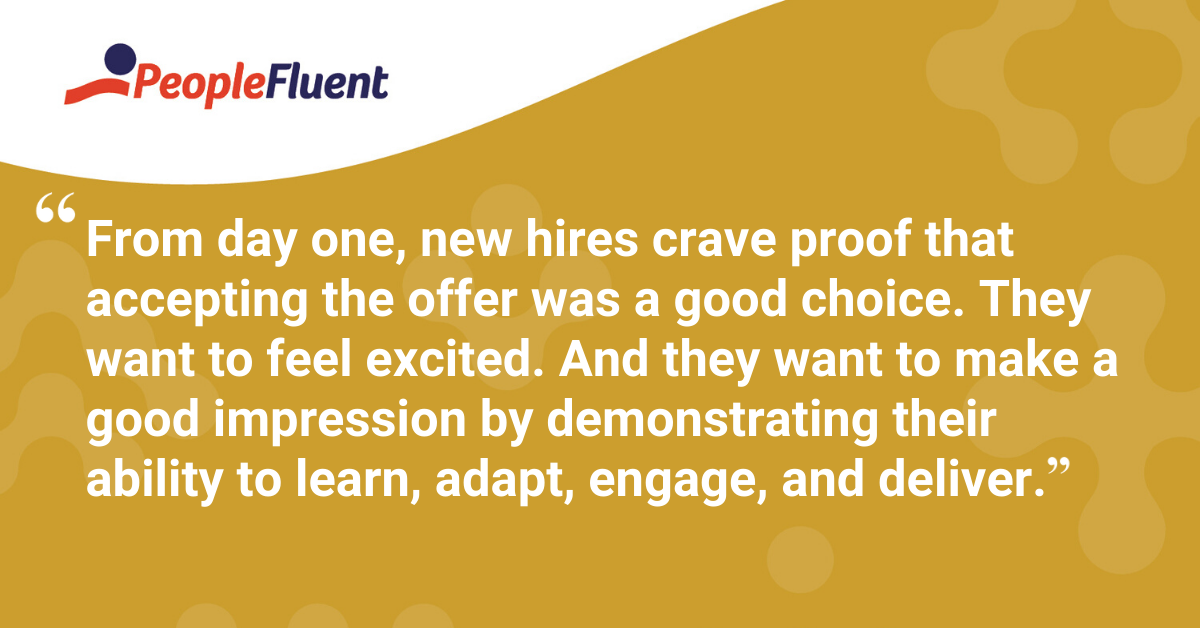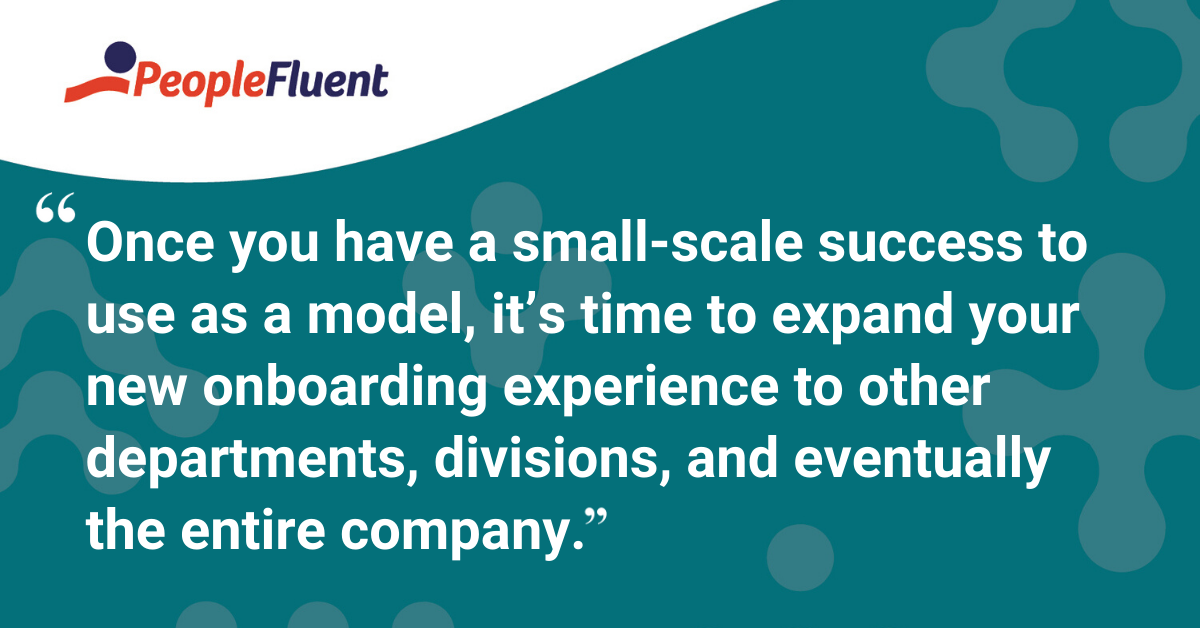Published: Oct 25, 2018Time to read: 9mins Category: Insights
9 Steps to a Better Onboarding Program
Table of Contents
So you've successfully recruited a new staff member. What now? The new hire experience is a critical aspect of onboarding. And getting it right builds a sense of connection and delivers real value for the organization by boosting employee retention, accelerating individual and team productivity, and increasing revenue. Here are nine steps to build an employee onboarding program that sets up your new hires for success.
12%! Out of millions of employees surveyed by Gallup, that’s how many said their employer does a great job of new hire onboarding. A paltry 12%.
Across industries, the state of the new hire experience is—let’s admit it—pretty sad. And this comes despite how much we know about the critical importance of setting new employees up for success, as shown by statistics on the impact of poor onboarding and the measurable benefits of successful new hire programs.
This also comes despite our own memories of terrible first days on the job, boring or nonexistent new hire orientation, lackluster welcomes from managers and leaders, and a glaring disconnect between what we expected and what we found.
In contrast, a great program builds a sense of connection and delivers real value for the organization in the form of boosts in employee retention, accelerated individual and team productivity, and concomitant increases in revenue.

Manifest Your Employer Brand in Your New Hire Experience
From Day One, new hires crave proof that accepting the offer was a good choice. They want to feel excited. And they want to make a good impression by demonstrating their ability to learn, adapt, engage, and deliver.
The good news is that this aligns perfectly with what the company expects and needs: a highly engaged and productive team member. How can you create a new starter that sets them up for success and convinces them to commit to your organization long-term?
Here are nine steps that will set your new hires up for success.
You might also like: 'Preparing Employees to Run on Your Fast Track: 10 Onboarding Best Practices'
1. Engage Recent New Hires
Lucky for you, the foremost experts on what it’s like to be a new hire at your organization are just an email or meeting invite away.
Gather your most recent cohorts together and mine their experiences for insights about your current new hire orientation program. Ask them open-ended questions like:
- Did you feel welcome?
- What do you wish you’d known in your first week?
- What would’ve made your first month better?
- Who was your most valuable resource during your 90 days?
Use their answers to fill in the gaps with the information and new hire experience they wish they’d had.
2. Start Before Day One
Whatever the structure of your new program, remember that great onboarding is a natural transition from the candidate experience.
It’s not a one-day event. Onboarding is a process that begins the moment your HR team generates an offer letter and includes the gap between their acceptance and their first day on the job.
If your recruiters are really invested, this first phase of onboarding can be as exciting as an unboxing experience. Examine your communications and scrutinize the experience from the perspective of your prospective new hires.
- Are you conveying the employer brand you promised on your careers page?
- What must your new hires do to accept the offer?
- What forms must they fill out?
- What resources can you give them to prepare for their first day?
Remember, every interpersonal and online interaction is part of the new hire experience. That means everything from parking information and dress code, to video welcome messages and social media groups to join.
Read more from the blog: 'Start Before Day One: How Learning Can Inform Talent Acquisition'
3. Lead with Culture and Stories
Every element of your new employee experience should reflect and reinforce a positive message about workplace culture. Everything you said, explicitly or implicitly, about your employer brand must shine through.
Consider the values, attitudes, and behaviors that define your company. If you’re innovative, your program must be innovative. If you’re caring, new hires must feel cared for.
Onboarding is also your first and best opportunity to engage new employees in company stories—for example, its founding, defining moments, and contributions to customers or communities. Through these stories—shared via eLearning, video, or in-person activities—your new hires will be able to
- Understand the company’s roots and core values
- Experience and adopt desired attitudes toward their work, clients, and colleagues
- See and emulate the behaviors that are expected and necessary for success.
By enabling new hires to experience these crucial elements of your culture, you can create that sense of belonging new employees crave.
4. Make It a Social Experience
New hires want and need to feel connected—to their managers, coworkers, distributed colleagues, and leaders. The best way to do this is by creating a centralized platform designed for social connection and peer-to-peer collaboration.
From this platform or portal, your new hires should be able to:
- Learn about and join employee affinity groups
- View a calendar of social and wellness activities
- Access chatrooms or group chats focused on professional and/or personal interests
- Watch videos that introduce new hires to leadership and bring your company culture to life.

Keep reading: 'Onboarding Checklists: 6 Benefits for Talent Acquisition Leaders'
5. Go Beyond a Digital Onboarding
While the digital component of your new starter program is vital, remember to include opportunities for face time and create opportunities for existing employees to reach out to their new colleagues. For example, you might:
- Define milestones at which HR, managers, and perhaps others will check in with new employees
- Assign a mentor or new hire buddy to serve as an in-office resource for simple logistical questions
- Organize a monthly new hire lunch with one or more executives to create an opportunity for Q&A, feedback, and engagement in the company’s mission.
These in-person activities also serve to engage your leaders and seasoned employees in making new people feel welcome, further reinforcing a culture of connection and shared goals.
6. Consider the Career Journey
Given that lack of opportunity is the top reason people change jobs, it’s never too early to engage employees in career growth options.
Your program should introduce new team members to L&D opportunities beyond the usual safety training, handbooks, policies and procedures, and other required learning. Great onboarding goes beyond compliance to send a clear message that your new hires will be able to grow professionally in their role and at your organization.
For example, during their first few days or weeks, you can showcase stories of employees whose careers began at entry level and progressed into management and leadership. And you can highlight all the ways the company invests in employees, including eLearning offerings, rotational assignments, cross-training, mentorship, career coaching, and tuition reimbursement.
Recommended for you: 'How COVID-19 Has and Will Change Recruiting Strategies'
7. Create a Pilot Program for New Starters
Once you’ve mapped out the essential components of your ideal program, take a pilot or prototype approach. Test your ideas and processes at a small scale, measure outcomes, and build on what worked best.
For starters, identify a department or business unit within the organization whose leader sees the value of great onboarding and is committed to getting it right. Ideally, your chosen champion will have experience and proven success with the process from a prior organization, but enthusiasm is equally important.
Define your new program and implement it with a new hire cohort of manageable size or with a series of single new hires. Run the program with 5-10 new hires and then evaluate your results.
8. Measure Outcomes
Measure the quantitative and qualitative impacts of your new program in terms of retention, morale, and productivity and business impacts. Survey your new hires and their managers, as well as recruiters and other HR teams who were involved.
Ask new hires about their satisfaction with their decision to join the company, experience with the program, and likelihood to refer people in their network for career opportunities with the company.
Ask managers how new hire productivity, contributions to team goals, and culture fit. Ask recruiters and HR teams for qualitative feedback based on their observations and professional expertise.
To the extent you can, quantify the business impacts of your program. For example, for new sales associates or account executives, compare revenue generated within the first 90 days by graduates of your new program to prior new hires.

9. Document, Scale, and Evangelize
Once you have a small-scale success to use as a model, it’s time to expand your new onboarding experience to other departments, divisions, and eventually the entire company.
To do that, you’ll need to document the process in an onboarding checklist to simplify adoption of the program and encourage consistency. Within that checklist, identify opportunities for each department to tailor the process to its needs for specialized training, team culture, and other elements.
Then take your champion and his or her first cohort of new hires on a tour to spread the enthusiasm and replicate their successes.
Commit to a Great "Welcome Aboard" Experience
Great onboarding programs encompass much more than a one-day or even one-week orientation. They can last 90 days or even a year. And they involve HR, executives, hiring managers, and new hires and create a strong sense of belonging and purpose.
Remember, your company culture is created anew each day by leaders and employees. To ensure your new starter process evolves alongside culture, your leaders and HR teams must commit to reviewing and refining the onboarding and induction experience over time.
With a solid commitment, your program can become a true differentiator, energizing the employees you hire today and attracting the talent you will need in the future.
Recommended reading to download today: '5 Recruiting Metrics that Drive Business Value'
Master Your Onboarding Program With Comprehensive Software
PeopleFluent software helps you tailor the onboarding process to meet the needs of your most valuable assets, your people.